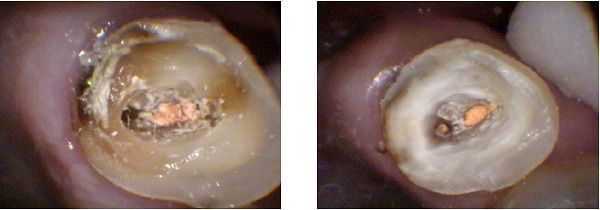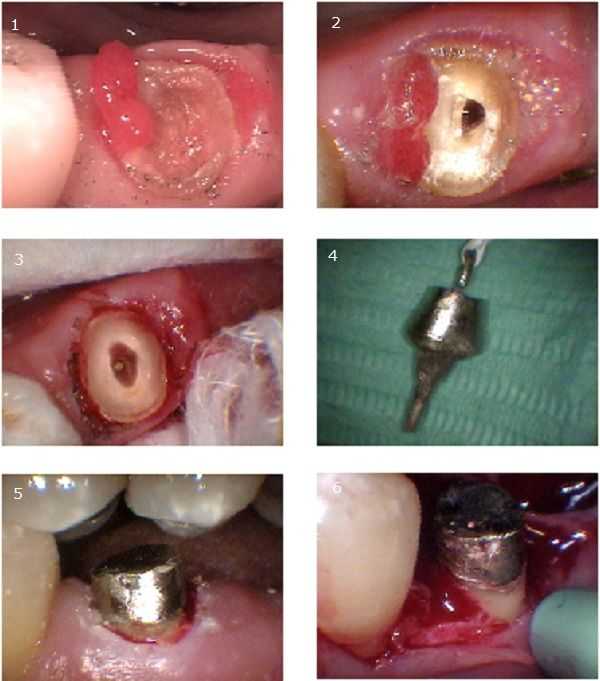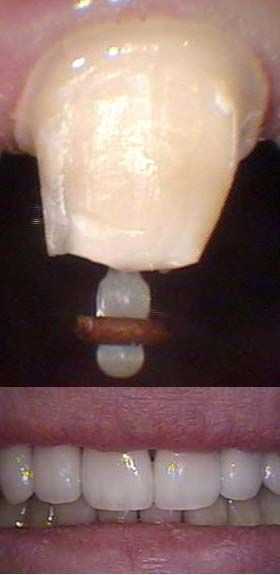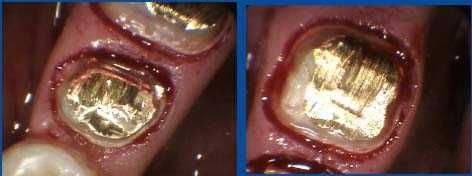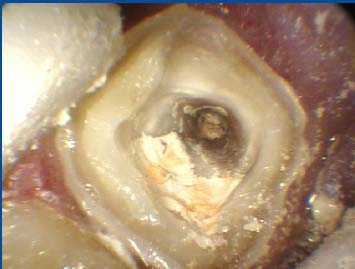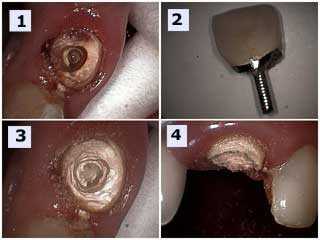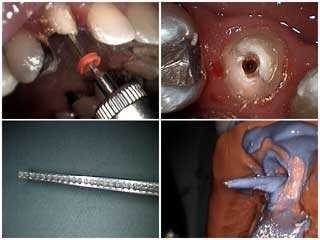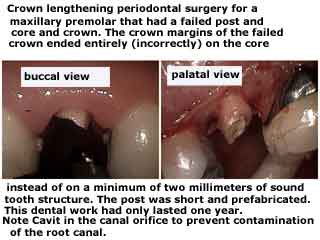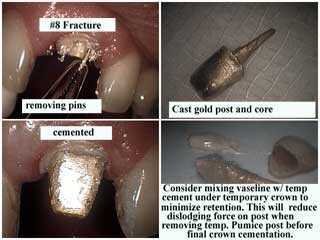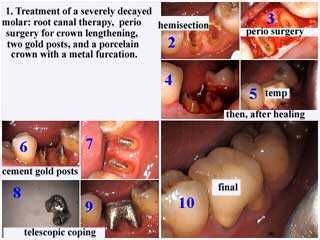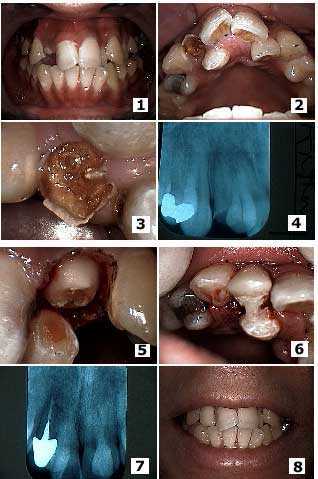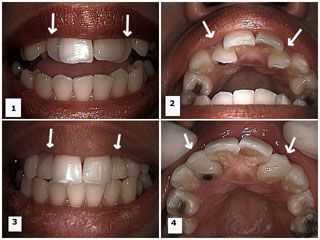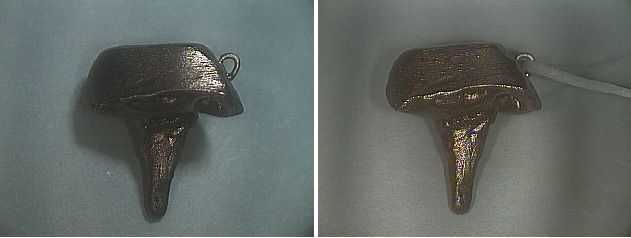Photos on tooth preparation and impression for gold post core created in our General Dentistry office.
Post space preparation. Tooth decay is removed except on the disto-lingual perimeter; it will be removed after the post is inserted, during the crown preparation. Excess gutta percha has been removed from the pulp chamber so that the cast gold post and core will fit against rigid tooth structure. The path of draw for the post was created by angling the coronal portion of the post space in a palatal direction.
Need for a cast post and core. Picture #1 – after removing an old crown this tooth had a lot of decay below the gum. Picture #2 – following endodontic (root canal) therapy. Picture #3 – the root canal was reshaped into an oval to prevent rotation of the cast post & core. Note the root canal filling material (gutta percha) inside the root canal. A gingivectomy was performed to remove the gum on top of the tooth and then an impression was made for the cast post & core. Picture #4 – the cast post & core with a Kaitlyn Loop. A long piece of dental floss is tied through the Kaitlyn Loop. This will help prevent accidental swallowing of the cast post & core. Picture #5 – the cast post and core is cemented. The occlusal clearance is checked. Picture #6 – crown lengthening surgery was then performed and sutured with 4-0 chromic gut. A temporary crown was placed and then periodontal packing was placed last.
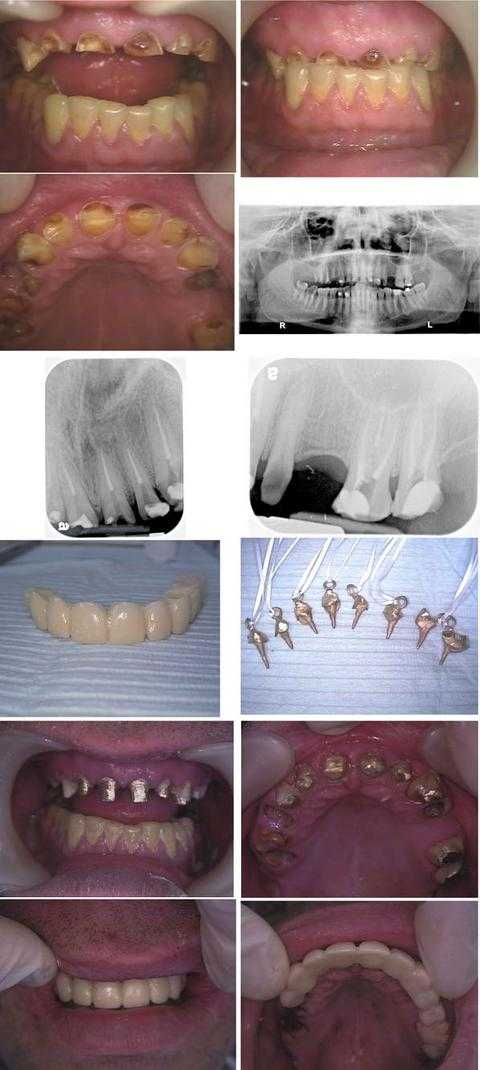
Dental Reconstruction of a phobic Wall Street executive with Cast Gold Post and Cores. Total treatment time was about nine hours in two visits during one business week: Monday (four hours) and Friday (five hours). This patient hid his dental condition for over a decade by refusing to smile.
In the first row of photos, note that the teeth bite occlusion was over-closed due to a prior history of an eating disorder, now controlled, and a current teeth grinding habit.
An Oral Surgery consultation with panoramic x-ray (second row) was performed prior to treatment to evaluate opening the dental bite.
The third row shows xrays taken after the Endodontist completed root canal on eight teeth during the first day on teeth #’s: 6 – 11 and 14, 15.
The fourth row shows the dental lab processed 11 teeth provisional temporary dental bridge and the Cast Gold Post and Core – with Kaitlyn loops – for the root canal treated teeth.
The fifth row photo occurs after cementation of the Cast Gold Post and Cores. The Kaitlyn Loops were drilled off after the dental cement dried. The purpose of Kaitlyn Loops is to allow threading of dental floss to make the Post and Core retrievable – and not swallowed – if it drops in the back of the mouth.
The sixth row shows the dental laboratory processed temporary teeth bridge in place after the oral surgeon extracted teeth #’s: 3 – 5 and 12, crown lengthening gum surgery was performed on teeth #’s: 6 – 11, and a distal wedge was performed on #15.
The patient will have a final porcelain metal dental bridge made after the gums heal. Dental iplants may also be placed in the upper right posterior. A bite plate is also necessary to try to mitigate the force of teeth clenching – bruxism. Referral for pharmacological management of anxiety is also worthwhile. Before and after pictures.
FiberLux Esthetic Post System placed in #9 instead of cast gold Post and Core. This was chosen to allow translucency of the Creation Pressed Ceramic porcelain dental crowns 7 – 10 next to porcelain teeth veneers 4 – 6 and 11 – 13. It is important to keep the tooth stump shade as light as possible when offering a premium smile makeover – oral rehabilitation. Treatment photos of a dental patient who visited from China.
Two cast gold Post and Cores. The distal dental crown margin of the tooth in the left photo went into the gingival sulcus – below the gum, but not so deep that crown lengthening gum surgery was needed. I chose to end the dental crown margin on the gold Post and Core casting in the distal part of the preparation only. On the tooth in the right photo I chose to end the dental crown margin in the more typical manner, which is on two millimeters of sound tooth structure 360 degrees around the tooth. Sometimes rules can be broken if logic dictates.
Post space preparation photo for a Cast Gold Post and Core. This should be performed by the endodontist following root canal therapy because he/she is most familiar with the internal tooth root anatomy.
An upper anterior porcelain tooth crown failure is shown in these pictures. 1) Tooth decay. 2) The failed porcelain dental crown with the prefabricated Post and Core still in it. 3) and 4) Tooth preparation to determine the necessity for crown lengthening gum surgery. A prefabricated Post and Core comes in a kit of various sizes. The dentist tries to find the best fit and threads it with dental cement inside the root canal of the tooth. They are frequently made of gold plate NOT solid gold. We prefer to use a Cast Gold Post and Core in our patients. Cast Gold is solid gold custom made to fit most accurately into the root canal of each individual tooth and thus giving the highest likelihood of long term strength and durability.
Cast Gold Post and Pore technique. How to Pictures. Photo 1) Low speed drill post space preparation. 2) Occlusal photo of the post space preparation within the root canal. Photo 3) This plastic serrated sprue will be incorporated into the dental impression material (next photo) after being reduced occlusally to allow proper occlusion teeth bite for a triple tray impression. 4) The dental impression incorporating the plastic sprue. This impression will be used by the dental laboratory to make a custom cast gold post and core that should exactly match this dental impression.
Two pictures of a crown lengthening periodontal gum surgery for a maxillary premolar tooth that had a failed prefabricated Post and Core and dental crown. If the Post and Core fails then the dental crown will usually have to be remade as well. The text in the image says: Crown lengthening periodontal surgery for a maxillary premolar that had a failed post and core and crown. The crown margins of the failed crown ended entirely (incorrectly) on the core instead of on a minimum of two millimeters of sound tooth structure. The post was short and prefabricated. This dental work had only lasted one year. Note Cavit in the canal orifice to prevent contamination of the root canal.
An upper front broken tooth #8 that was treated with a Cast Gold Post and Core. How to pictures. This Post and Core was made in solid gold to accurately fit the shape of the root canal in this tooth. The closer the fit then the thinner the dental cement thickness and the stronger the Post and Core should be retained within the tooth root canal.
Consider avoiding placing temporary dental cement in the coronal half of the temporary dental crown to minimize retention and therefore decrease the amount of force needed to remove it when making the final porcelain dental crown. This will reduce the dislodging force on the post when temoving the temporary crown. Pumice the post before final porcelain crown cementation to remove any residual dental plaque.
Treatment of a mandibular molar with severe dental caries tooth decay::
– root canal therapy.
– periodontal gum surgery for crown lengthening.
– two Cast Gold Post and Cores.
– porcelain tooth crown with a metal furcation.
Classic periodontal-prosthesis dentistry taught at the University of Pennsylvania School of Dental Medicine in Philadelphia.
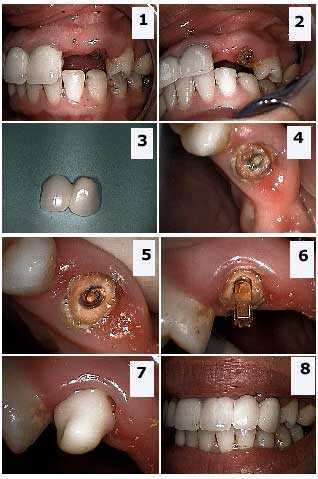
Tooth crown and bridge repair. How to pictures. 1) – 4) A new patient presented with a two teeth porcelain fused to metal dental bridge that had come out. The teeth bridge abutment was on the upper left canine tooth #11 and it was cantilevered in the upper left lateral tooth position #10. The patient had recently moved to NY and then lost his job in the computer industry and was financially unable to properly rebuild this area at this time. The patient sought a temporary tooth repair though he knew this would ultimately sacrifice the already badly damaged, and possibly untreatable, canine tooth. 4) The canine abutment had significant tooth decay cavity. 5) The tooth decay was removed from the canine and a space was created for a prefabricated Post and Core. 6) A prefabricated Post and Core was cemented into place. 7) A chemically cured dental bonding material was added to the Post and Core and the dental bridge was placed on top, and occasionally removed, during hardening. 8) The teeth bridge was cemented onto this new abutment using chemically cured teeth bonding material and a little bonding was also added to the distal of the left central incisor tooth #9 to help support the cantilever during vertical loading. The patient understands the need for more comprehensive care when circumstances allow. An appropriate informed consent was created and signed.
Treatment of an upper lateral incisor tooth – with severe dental caries tooth decay – adjacent to a palatally-displaced supernumerary tooth. Photos 1) – 2) Initial presentation. Note the broken tooth lateral incisor with a big dental cavity and the palatal location of the adjacent supernumerary tooth. 3) Close up photo of the broken, decayed lateral tooth and the adjacent palatally-displaced supernumerary tooth. 4) Radiograph x-ray. 5) The same tooth after periodontal gum surgery and initial tooth preparation. 6) Placement of the temporary dental crown. Note that acrylic was extended from the temporary dental crown on the lateral to the supernumerary to provide initial stability of the temporary until root canal therapy and a Cast Gold Post and Core was cemented. 7) Radiograph xray of the final root canal therapy, Cast Gold Post and Core and porcelain dental crown. 8) Final result photo.
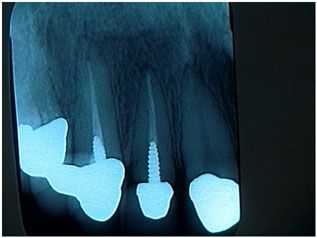
When not to treat a patient. This woman was a very nice, 30-something year-old who presented for what she believed would be a quick recementation of a single, upper lateral tooth crown. Many teeth crowns and root canals were recently completed by her local dentist near her home. She indicated that she had a good relationship with him.
There were many reasons why I chose not to treat this patient and instead recommended that she go back to her current dentist for care. 1) It appeared that this dental crown is completely seated – 360 degrees – on the Post and Core instead of being seated on a minimum of two millimeters of sound tooth structure. 2) The Post preparation was short and should have been nearly double its length for strength and retention. 3) The Post was prefabricated gold plate and not custom cast in solid gold; this will also decrease its strength and retention.
I did not want to take out the loose tooth crown and then find that I also had a loose Post and Core in my hand. Proper care might indicate a new, longer Cast Gold Post and Core, possible crown lengthening gum surgery, and a new dental crown. Crown lengthening surgery could likely affect the teeth crown margins on all the other new anterior dental crowns.
Once you touch it, you own the problem. Both the dentist and patient need to agree in writing what might happen, and what then might need to be done, if an “easy” repair turns out to be quite a big problem. This philosophy is both fair and appropriate for the patient and will save a lot of young dentists from having a major, unexpected problem. All things considered it was not worth getting started. The patient was appreciative of my assessment and was happy to return to her dentist for the repair.
The Kaitlyn Loop can be cast with both a Post and Core – as seen in these pictures – and with dental crowns. About 12 inches of dental floss is inserted through the Kaitlyn Loop with both ends remaining extra oral during try-in and dental cementation. This will help prevent accidental swallowing of a Cast Post and Core or tooth crown if it is dropped in the back of the mouth.
Before and after pictures show how to make crooked teeth appear straight without orthodontics teeth braces. The two teeth treated here in these photos were the upper lateral incisors. Each tooth received root canal therapy and a Cast Gold Post and Core that was reoriented in the desired labial direction. 3/4 porcelain dental crowns were then placed to give the appearance that these teeth were straight.
Kaitlyn loop vs. lingual button. The Kaitlyn Loop can be cast with both post and cores (as seen here) and crowns. About 12 inches of dental floss is inserted through the Kaitlyn Loop with both ends remaining extra-oral during try-in and cementation. This will help prevent accidental swallowing of a cast post and core or crown if it is dropped in the back of the mouth.
